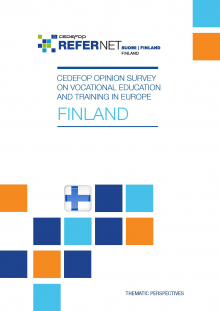Vocational education and training (VET) in Finland has an excellent reputation. Popularity of VET as a learning option has increased steadily since the early 2000s; currently, more than 40% of the relevant age group applies for VET studies immediately after basic education. However, building on earlier reforms, Finland plans more changes to its VET system.
Over 8 in 10 Finns (84%) said that VET has a positive image, according to an opinion survey carried out by Cedefop to gain insights into the views EU citizens have about VET at upper secondary level.

Source: Cedefop’s VET opinion survey
Finnish VET matches well with the needs of work: 96% of survey respondents agree that people in VET learn skills that are needed by employers, compared to the EU average of 86%. Students also benefit from studies that take into account their individual needs; 84% of Finnish VET students are very satisfied with the different aspects of their studies compared to 72% in the EU as a whole.
Finland offers many opportunities to continue studies after initial VET. The survey reports that 64% of Finns agree it is easy to continue into higher education, compared to 54% in the EU overall. Finnish VET students also have more opportunities to study abroad. Every year, more than 13% of new Finnish vocational students go abroad for two to three weeks of on-the-job learning. Campaigns and skill competitions organised by the government and social partners, such as the annual SkillsFinland, have improved VET’s image across various sectors including metalwork and machinery, and natural and environmental protection.
Some 97% of Finnish respondents to the survey agreed that VET strengthens the economy and 94% agreed that it plays a role in reducing unemployment. However, the overwhelming majority of Finns (88%) believe that general education has a better image than VET. Expectations of employment are also not so positive: 63% of Finns agree that VET allows you to find a job quickly after graduation (see figure).
The survey shows that the employment prospects for VET graduates are not as good as for those who complete higher education. This view is probably influenced by the relatively high unemployment rate (14%) among young people in Finland. Consequently, as part of the effort to combat youth unemployment, Finland is continuing its VET system reforms. The aims include making access to VET easier, and greater individualisation of people’s learning pathways. Learning environments are becoming more varied with more learning at the workplace.
Finland’s efforts to make a good system better reflect the need to keep up as much as possible with changes in the labour market. World class VET systems are always evolving.
Notes
- More in Cedefop opinion survey on vocational education and training in Europe: Finland (in English only)
- Cedefop’s opinion survey, published in 2017, provides new insights into what Europeans think of vocational education and training (VET), its ability to give people the right skills and to help VET graduates to find a job. The survey aims to inform policies to make VET a more attractive and effective learning option. It was conducted in June 2016 and examined EU citizens’ awareness and opinions on VET’s attractiveness and effectiveness, and personal experiences of VET at upper secondary level (typically age 16 to 18). The survey comprised more than 35 000 interviews of a representative sample of Europeans across all EU Member States.
- Watch a new Cedefop video on Finland’s VET system published on the occasion of the current Finnish EU Presidency.


